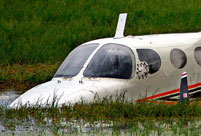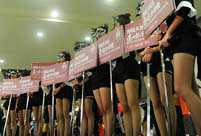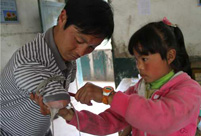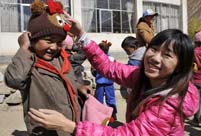The reform and opening-up drive has quickened Tibet's development.
Over the past 30 years or more, through reform and opening up, Tibet has been proactively promoting commerce, foreign trade and tourism. It has increased exchanges with other parts of China as well as communication and cooperation with foreign countries. In 1993 Tibet began to develop the socialist market economy with the rest of the country, developing into a new system within the same framework. Reforms have been carried out in the pricing and circulation of goods and materials, grains, and consumer goods, all of which have entered the market system. Currently Tibet is incorporated into the national market system. Commodities from all over the nation and across the world keep flowing into Tibet, enriching the urban and rural markets as well as the lives of the people. At the same time, well-known and quality products with local characteristics and folk handcrafts are transported to other parts of the country in large quantities.
Economically, Tibet is now more and more closely linked to the world. In 2012 the total volume of its foreign trade reached 3.424 billion U.S. dollars, more than 850 times that of 1953, which stood at 4 million U.S. dollars, with an annual growth rate of 12.1 percent. By the end of 2012 actualized foreign investment in Tibet was 470 million U.S. dollars. Taking advantage of its geographical position, Tibet is strengthening friendly cooperation with India, Nepal and other neighboring countries. To promote border trade, it is building a "commodity passageway" to South Asia via the land route, and has built trading centers in such port cities as Gyirong, Zhangmu, Yatung, Pulan and Riwu.
【11】 【12】 【13】 【14】 【15】 【16】 【17】 【18】 【19】 【20】
【21】 【22】 【23】


 No news of survivors in Lao Airlines crash
No news of survivors in Lao Airlines crash Five fighters in flight training
Five fighters in flight training London mayor hails free trade, subway system on China tour
London mayor hails free trade, subway system on China tour Different eye catching shows at housing fairs in China
Different eye catching shows at housing fairs in China Chalk it up to great courage
Chalk it up to great courage Tibetan girl helps mobilize volunteers onlin
Tibetan girl helps mobilize volunteers onlin Lingerie show dazzles Wuhan Motor Show 2013
Lingerie show dazzles Wuhan Motor Show 2013  Chinese screen goddesses from Beijing Film Academy
Chinese screen goddesses from Beijing Film Academy  Weekly Sports Photos
Weekly Sports Photos Bayi Parachute Team of PLA Air Force
Bayi Parachute Team of PLA Air Force World has never been dark-- a blind kid’s life in Tibet
World has never been dark-- a blind kid’s life in Tibet Change to law may make it easier to sue polluters
Change to law may make it easier to sue polluters UNESCO world heritage site: Montale Tower
UNESCO world heritage site: Montale Tower U.S. Senate leader announces bipartisan deal
U.S. Senate leader announces bipartisan deal Fiber-optic wedding dress show shinning in Suzhou
Fiber-optic wedding dress show shinning in Suzhou Day|Week|Month